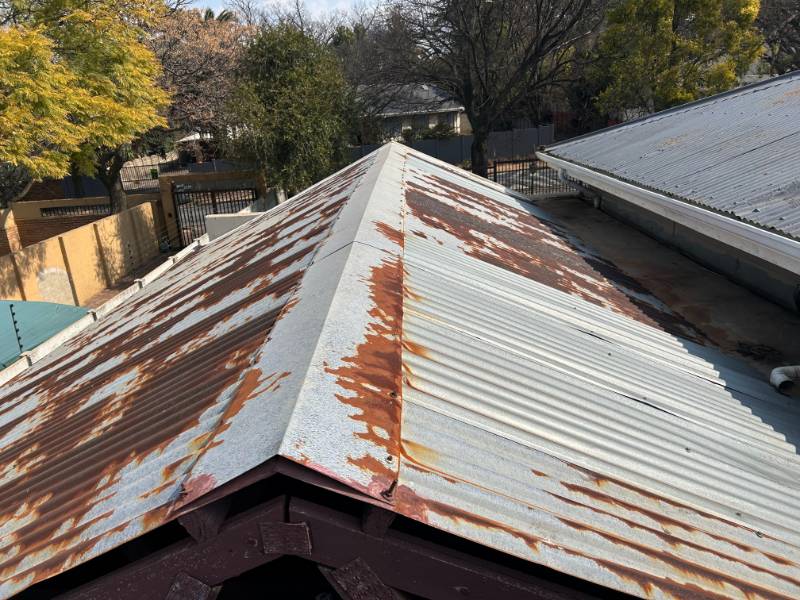
Metal Roof Waterproofing and Rust Prevention
Metal roofs are tough and long-lasting — but once rust starts, it can spread fast and cause serious damage. I’ve seen it happen too many times: a small rust patch turns into a full leak because the waterproofing wasn’t done correctly or the wrong materials were used.
In this post, I’ll walk you through the best ways to waterproof metal roofs, how to stop rust before it spreads, and what I’ve learned from years of repairing roofs across Johannesburg’s heat and summer storms.
Why Metal Roofs Leak and Rust
Metal expands and contracts with temperature changes. Over time, this movement loosens screws, opens seams, and cracks old sealants. Once water finds its way in, it collects in those tiny gaps — and rust takes over.
The main causes I see on site include:
- Poor sealing around overlaps, screws, or skylights
- Rust spreading from small scratches
- Faded or peeling protective coatings
- Water pooling near joints or gutters
- Old, brittle waterproofing layers
Last month, I repaired a factory roof in Midrand where the owner had ignored a few rusty spots for years. When we lifted the sheets, we found entire panels corroded through. We cleaned, treated, sealed, and applied a new liquid rubber waterproofing system — it’s now fully protected and leak-free.
Step 1: Surface Cleaning and Rust Treatment
Before waterproofing, the roof has to be spotless. Dust, grease, or old paint will prevent proper adhesion. We start with high-pressure washing to remove dirt and rust flakes, then apply rust converter to neutralize corrosion.
If you’ve got a badly rusted roof, our Rust Treatment for Metal Roofs service restores the surface before sealing to ensure the waterproofing lasts.
Step 2: Sealing Joints, Screws, and Flashings
The weakest points on any metal roof are the joints and fasteners. Screws often loosen over time, and flashing sealants dry out. I reseal every joint with high-quality, UV-resistant polyurethane sealant and tighten or replace worn fasteners.
If water seeps through these areas, it can quickly spread under the sheets — that’s why this step is crucial before applying any coating.
To handle flashing problems around edges or skylights, see our Roofs Flashing Repairs service.
Step 3: Apply Liquid Rubber Waterproofing
For metal roofs, nothing beats liquid rubber waterproofing. It’s flexible, seamless, and expands with the roof as it heats and cools. Once applied, it forms a thick, rubber-like membrane that completely seals the surface.
We use Liquid Rubber Waterproofing Systems for warehouses, homes, and factories across Johannesburg. It’s especially useful for corrugated or IBR sheets where other methods tend to crack or lift.
Step 4: Finish with a UV-Protective Coating
After sealing, we apply a reflective topcoat — usually an aluminium or acrylic protective coating — to prevent UV degradation. This not only keeps the roof cooler in summer but also extends the waterproofing’s lifespan by protecting it from sun damage.
Learn more about our Protective Coatings Services for long-term roof protection.
Step 5: Regular Maintenance
Even the best waterproofing won’t last forever without care. Johannesburg’s harsh sun and storms can wear down coatings over time. I recommend inspecting your roof at least once a year, tightening screws, and touching up any worn areas.
Our Roof Maintenance Plans in Johannesburg help homeowners and businesses stay ahead of leaks and corrosion before they become serious problems.
Common Mistakes to Avoid
- Painting over rust without treatment — it just traps moisture and makes it worse.
- Using roof paints instead of waterproof coatings — they’re not flexible enough.
- Skipping surface prep — waterproofing won’t stick to dirt or flaking paint.
- Ignoring small leaks — water spreads fast under metal sheets.
If you’re not sure what’s causing your leak, it’s better to get it checked early. I offer free call-outs across most of Johannesburg, and I’ll show you exactly what’s wrong before you spend a cent.
Final Thoughts
A well-maintained metal roof can last 30 years or more — but only if it’s properly sealed and rust-free. Using the right waterproofing method and staying on top of maintenance will save you from major repairs down the line.
If your metal roof is leaking or showing rust, send me a message today. I’ll inspect it personally and recommend the best waterproofing and rust prevention plan for your roof.




